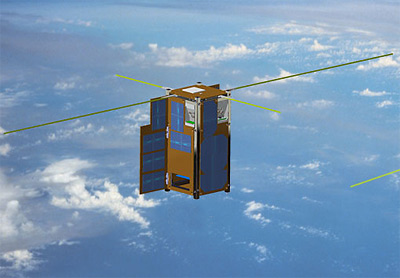Thank you very much for visiting Gunter's Space Page. I hope that this site is useful and informative for you.
If you appreciate the information provided on this site, please consider supporting my work by making a simple and secure donation via PayPal. Please help to run the website and keep everything free of charge. Thank you very much.
IRIS A

IRIS A [NCKU]
The IRIS A (Intelligent Remote-Sensing and Internet Satellite) nanosatellite is a technology demonstration 2U CubeSat of the National Cheng Kung University (NCKU) of Tainan, Taiwan.
The mission objective is to demonstrate Internet-of-Things (IoT) communication technology in space. Techniques are developed to compensate for the significant attenuation and Doppler shift in the mission so that ground measurements can be uplinked, stored, and forwarded. It is based on the Phoenix satellite.
The IRIS-A payload consists of
- Simple Camera (LISCOTECH)
- LoRa Receiver (LETSCOM)
- GPSR Device (NSPO)
- Reference Clock (NCKU)
| Nation: | Taiwan (Republic of China) |
|---|---|
| Type / Application: | Technology |
| Operator: | National Cheng Kung University (NCKU) |
| Contractors: | |
| Equipment: | |
| Configuration: | CubeSat (2U) |
| Propulsion: | |
| Power: | 2 deployable, fixed solar arrays, body mounted solar cells, batteries |
| Lifetime: | |
| Mass: | 2 kg |
| Orbit: |
| Satellite | COSPAR | Date | LS | Launch Vehicle | Remarks | |
|---|---|---|---|---|---|---|
| IRIS A | 2022-002BN | 13.01.2022 | CC SLC-40 | Falcon-9 v1.2 (Block 5) | with Umbra 02, Capella 7, 8, ICEYE X14, X16, Sich 2-1, ION-SCV 004, Dodona, STORK 1, 2, LabSat, SW1FT, VZLUSAT 2, ETV A1, BRO 5, HYPSO 1, Kepler 16, ..., 19, Flock-4x 1, ..., 44, FOREST 1, Lemur-2 149, 150, Lemur-2 146, 147, DEWA-Sat 1, NuX 1, IRIS A, MDASat 1a, 1b, 1c, Gossamer Piccolomini, Tevel 1, ..., 8, Challenger, Delfi-PQ 1, Unicorn 2A, 2D, 2E, FossaSat 2E1, ..., 2E6, MDQube-SAT 1, SATLLA 2A, 2B, Unicorn 1, EASAT 2, HADES, Grizu-263a, PION-BR 1, SanoSat 1, Tartan-Artibeus 1, USA 320, ..., 323 |
References:
- NCKU Space Lab: IRIS-A
Further IRIS missions:
